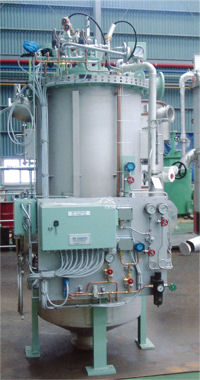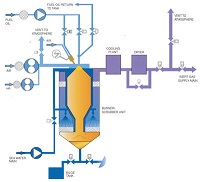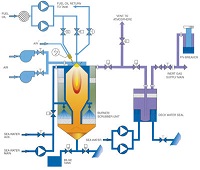
The Inert gas system is the most important integrated system for oil tankers. For a safe operation of the ship, inert gas is produced on board of crude of oil carriers, gas carriers, chemical carriers, bulk carriers when carrying fish flower, and in refrigerating ships when carrying fruit products. The inert gas is produced by using either a flue gas system or by burning Marine Diesel Oil ( MDO or MGO) in a dedicated inert gas generator.
Oxygen
Alternatively the vessel can produce clean Nitrogen by using a dedicated Nitrogen Generator. IG keeps the oxygen content of the tank/cargo hold below 8%, thus making any air/hydrocarbon gas mixture in the tank too lean to ignite. Inert gas is the gas which contains insufficient oxygen (normally less then 8%) to suppress combustion of flammable hydrocarbon gasses. The Inert gas system spreads the inert gas over the oil cargo hydrocarbon mixture which increases the lower explosion limit LEL (lower concentration at which the vapours can be ignited), simultaneously decreasing the Higher explosion limit HEL (Higher concentration at which vapour explodes). When the concentration reaches around 10%, an atmosphere is created inside the tank in which hydrocarbon vapours cannot burn. The concentration of inert gas is kept at around 5% as a safety limit.
Discharging cargo
IG is most important during the discharging of cargo and during the ballast voyage when more cargo and/or hydrocarbon vapour is likely to be present in the tank atmosphere.
Inert gas can also be used to purge the tank of the volatile atmosphere in preparation for gas freeing, replacing the atmosphere with breathable air or vice versa. Inert Gas can also be used for emptying cargo lines or Cargo pumps.
Get in touch with us
Components and description of IG system
 The following components are used in a typical inert gas system:
The following components are used in a typical inert gas system:
- Exhaust gasses source: Inert gas is taken from exhaust uptakes of the boiler or main engine as it contains flue gases.
- The Inert gas isolating valve: This serves as the supply valve from the uptake to the rest of the system, isolating both the systems when not in use.
- Scrubbing tower: Flue gasses enter the scrub tower from the bottom and pass through a series of water sprays and baffle plates to cool, clean and moist the gasses. The SO2 level decreases up to 90% and gas becomes clear of soot.
- Demister: Normally made of Stainless steel mesh, it is used to absorb moisture and water from the treated flue gas.
- Gas Blowers: Normally there are two fan blowers. One for the I.G operation and one for topping up purposes.
- I.G pressure regulating valve: The pressure within the tanks varies with the property of oil and atmospheric condition. To control this variation and to avoid overheating of a blower fan, a pressure regulator valve is attached after the blower discharge, which recirculates the excess gas back to the scrubbing tower

- Mechanical non return valve: This is an additional non return mechanical device in line with the deck seal.
- Deck isolating valve: The engine room system can be isolated with the deck system with the help of this valve.
- Pressure Vacuum (PV) breaker: The PV breaker helps in controlling the over or under pressurization of cargo tanks. The PV breaker vent is fitted with flame trap to avoid fire to ignite when loading or discharging is in operation.
- Cargo tank isolating valves: A vessel has a number of cargo holds. Each hold is provided with an isolating valve. The valve controls the flow of inert gas to hold and is operated by a specified officer in the vessel.
- Mast riser: The Mast riser is used to maintain a positive pressure of inert gas at the time of loading of cargo. During the loading operation this is kept open to avoid pressurization of cargo tank.